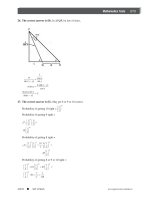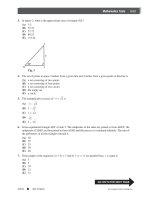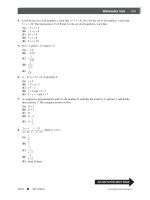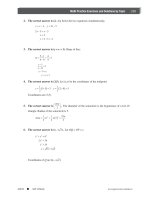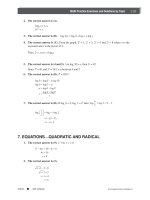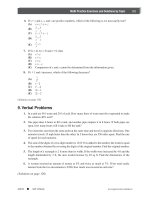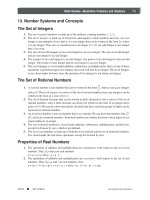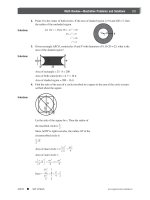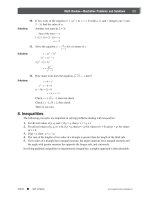SAT II Biology Episode 1 Part 4 pot
Bạn đang xem bản rút gọn của tài liệu. Xem và tải ngay bản đầy đủ của tài liệu tại đây (623.07 KB, 20 trang )
polar nature of water and refer to the fact that it attracts polar
substances. Choices (C) through (E) also reflect interactions that
result from the polar nature of water.
8. The correct answer is (E). The hydrogen bonds formed in
biological molecules refers to the positive nature of available
hydrogens, such as those found in the bases of nucleic acids, that
promote the nucleotide base pairing. In addition, electrostatic
forces are often associated with molecule-molecule binding, such
as that found in enzyme substrate complexes. Finally, choices (C)
and (D) represent large forces and, therefore, do not fit the
nature of the question posed.
9. The correct answer is (B). A peptide bond, formed when two
amino acids are joined, occurs at the site where the amino
group—NH
2
—of one amino acid and the carboxyl group—
COOH—are bonded. One H
1
of the amino group is removed and
coupled with an OH
-
from the carboxyl group to form water,
which is removed from the molecule, leaving two amino acids
bonded together. Choice (B) indicates the arrows that show
these bonding situations.
10. The correct answer is (D). Assembling the four fragments in
the following way:
lys-trp-arg
arg-pro-gln
pro-gln-his-lys
lys-asp-ala-gly
lys-trp-arg-pro-gln-his-lys-asp-ala-gly
indicates that choice (D) is the correct answer.
CHEMISTRY—ATOMS AND COMPOUNDS
57
Peterson’s n SAT II
Success: Biology E/M www.petersons.com
VOCABULARY
acidic
adhesion
amino acids
atom
basic
carbohydrates
cellulose
chemical reaction
cohesion
compound
condensation
dehydration synthesis
deoxyribonucleic acid
dipeptide
disaccharides
electron
elements
fat
glucose
glycogen
hydrogen bonds
hydrolysis
hydrophilic
hydrophobic
lipids
monosaccharides
neutron
nucleic acids
nucleotides
nucleus
organic compounds
oxidation
peptide bond
phospholipids
pH scale
polypeptide
polysaccharides
protein
proton
reactants
reduction
ribonucleic acid
specific heat
starch
synthesis
CHAPTER 1
58
Peterson’s n SAT II
Success: Biology E/Mwww.petersons.com
Chapter 2
CELLS—ORGANIZATION AND
REGULATION
OVERVIEW
Cells are the basic unit of living things. The student should demon-
strate a knowledge of the structure and function of cells as well as a
detailed knowledge of the cell organelles. This area includes the way
that cells divide and produce the next generation of cells. The
student should be able to compare and contrast mitosis and meiosis
with ease, including the phases of the cell cycle. A brief discussion of
the regulatory mechanisms involved in the life of the cell is included.
To begin with, we define the cell and discuss the cell organelles.
CELL TYPES
The principle types of cells on earth are the prokaryotic and eukary-
otic. Viruses are not considered living things by many scientists.
PROKARYOTIC
Prokaryotic cells lack the membrane-bound organelles found in
eukaryotic cells and consist of the Archaebacteria and Eubacteria.
They generally have a plasma membrane, a single DNA molecule not
coupled with protein molecules, small ribosomes, cytoplasm, and a
cell wall. If they possess flagella, they are different from the eukary-
otic flagella and cilia. There are two very different kinds of prokary-
otic cells, those called bacterial (including cyanobacteria or blue-
59
Peterson’s n SAT II
Success: Biology E/M www.petersons.com
green algae) and those called Archaea. Many Archaea can tolerate
extremes of temperature, pressure, pH, and salinity. Prokaryotes have
a much simpler structure than eukaryotes.
EUKARYOTIC
Eukaryotic cells contain some or all of the components listed below
and are found in or compose all of the non-prokaryotic living things.
Evolutionarily, they are “younger” than the prokaryotes.
Membrane
Encloses the material in the cell and regulates the passage of material
into the cell from the surrounding environment.
A. Fluid mosaic model
Describes a phospholipid bilayer as the foundation of a plasma
membrane. The polar, hydrophilic end lies on the outside of the
Eukaryotic cell
Cross-section of cell membrane
showing fluid-mosaic nature
CHAPTER 2
60
Peterson’s n SAT II
Success: Biology E/Mwww.petersons.com
bilayer, and the nonpolar, hydrophobic end lies on the inside.
Embedded in the bilayer are cholesterol and a variety of protein
molecules, and carbohydrates are located on the outside of the
membrane.
1. Channel (transmembrane) proteins—provide for the passage of
certain water-soluble substances across the membrane.
2. Electron transfer proteins—transfer electrons from one molecule
to another.
3. Receptor proteins—sites that act as receptors for trigger mol-
ecules that cause a cell response within the cell.
4. Recognition proteins—recognize and help in some cells sticking
to other cells.
5. Transport proteins—use energy from ATP to transfer material
across the membrane in a process called active transport.
B. Transport across the membrane
There are a variety of instances in which substances need to be
transported across the membrane, both in and out. Some molecules
diffuse through the membrane, and others require special transport
proteins.
1. Selectively permeable membrane—any membrane through
which only certain substances can pass. This process is dictated
by several factors as explained below.
2. Diffusion—random movement of particles from an area of
greater concentration to an area of lesser concentration, produc-
ing a diffusion gradient
3. Osmosis—diffusion of water
4. Plasmolysis—osmosis directed outward from the cell and leads
to cell collapse
CELLS—ORGANIZATION AND REGULATION
61
Peterson’s n SAT II
Success: Biology E/M www.petersons.com
5. Facilitated diffusion—diffusion of water-soluble substances aided
by channel proteins
6. Active transport—energy aided transport using ATP and trans-
port proteins in the membrane
7. Exocytosis—movement of substances out of the cells within
membrane vesicles, which release to the exterior of the cell
8. Endocytosis—movement of substances into the cell within the
cell membrane
• Phagocytosis—plasma membrane engulfs an undissolved
substance (usually whole cells or cell parts) too large to
pass through the membrane.
• Pinocytosis—plasma membrane engulfs a dissolved
substance—and therefore water as well—too large to pass
through the membrane.
CHAPTER 2
62
Peterson’s n SAT II
Success: Biology E/Mwww.petersons.com
Cell organelles
Cell organelles are specialized structures within the cell that house
specialized functions.
A. Cell walls
While not strictly an organelle, cell walls are found only in plants,
fungi, some protists, and some bacteria; they consist mainly of
cellulose in plants and help control osmotic uptake of water.
B. Centrioles
Give rise to spindle fibers that aid in mitosis. Almost exclusively
found in animal cells.
C. Chloroplasts
The site for photosynthesis in plants cells, they contain photosyn-
thetic pigments, including chlorophyll.
H
I
H - mitochondria
I - endoplasmic reticulum
CELLS—ORGANIZATION AND REGULATION
63
Peterson’s n SAT II
Success: Biology E/M www.petersons.com
D. Chromosomes
Genetic material in the nucleus of the cell, they pass on hereditary
information and regulate the cell through the production of proteins.
E. Cilia and flagella
Have the same construction and aid in the movement of individual
cells or movement of water past cells that are part of tissues, like
lung epithelium.
F. Endoplasmic reticulum (ER)
Both smooth (no ribosomes embedded) and rough (ribosomes
embedded) ER. The rough ER is the site where ribosomes make
proteins for use in the cell and for export from the cell with the aid
of the various RNAs. Smooth ER makes lipids and detoxifies enzymes.
CHAPTER 2
64
Peterson’s n SAT II
Success: Biology E/Mwww.petersons.com
G. Flagella
Longer than cilia but of the same material, they aid the cell in
movement with a wave-like motion.
H. Golgi bodies
Also known as Golgi complex or apparatus, they are the site where
proteins are modified and other proteins are packaged for release
from the cell.
I. Lysosomes
Contain digestive enzymes that metabolize substances for the cell,
and even the cell itself, if it ages too much.
J. Microfilaments
Aid in the movement of substances in the cells as well as helping
cells that change shape to move.
K. Microtubules
Provide support for the cell. Microtubules and microfilaments
comprise the cytoskeleton of eukaryotic cells.
L. Mitochondria
The “powerhouse” of the cell, it is the site of ATP synthesis only in
aerobic respiration on the enfolded, inner membranes, which are
known as cristae.
M. Nucleolus
A densely staining region of the nucleus where there are multiple
copies of genes for making ribosomes. It contains rRNA.
CELLS—ORGANIZATION AND REGULATION
65
Peterson’s n SAT II
Success: Biology E/M www.petersons.com
N. Nucleus
A double-phospholipid-bilayer-bounded control center of the cell. It
contains DNA, proteins known as histones, and the nucleoli.
O. Peroxisomes
Organelles that break down substances in cells, usually toxins.
P. Ribosomes
The site of protein synthesis in the cell, they are composed of
ribosomal RNA.
Q. Vacuoles
Usually found only in plant cells in the form of large storage areas.
Plant cells
Plant cells have an outermost cell wall that provides support but is
primarily for osmotic control, chloroplasts where photosynthesis
takes place, and a large vacuole filled with cell sap that contributes to
the rigid nature of plant cells.
Animal cells
Animal cells have centrioles that take part in cell division; some have
flagella or cilia, as do some plant cells, and some are able to engulf
solid matter.
Cell cycles
There are three stages in the reproductive cycle of every eukaryotic
cell: interphase, karyokinesis, and cytokinesis. Interphase and
karyokinesis comprise a sequence of events called the cell cycle that
includes growth and replication of DNA. When cells divide to make
other cells, it is necessary for them to copy their DNA so that
daughter cells will each have a full set of information for controlling
the cells’ activities. The replication of eukaryotic cells is described by
the cell cycle. In a typical multicellular eukaryotic organism, some
cells will be actively dividing (in the cell cycle), such as skin cells in
humans, and some will not. During the cell cycle, cells grow,
replicate their DNA, grow some more, and then direct equal copies
of their DNA (chromosomes) into two groups that will become the
two nuclei of the daughter cells. Usually, the cell divides immediately
(cytokinesis), but that process is not connected to mitosis. Often,
mitosis occurs without cytokinesis, resulting in cells with more than
one nucleus.
CHAPTER 2
66
Peterson’s n SAT II
Success: Biology E/Mwww.petersons.com
A. Interphase
Formerly thought to be the resting phase of mitosis since little could
be seen happening, it is actually a very active phase in the life of the
cell. It includes two growth phases, known as G1 and G2, and an S
phase. Following these phases, the cell undergoes mitosis, or an M
phase, when karyokinesis occurs, followed soon thereafter by
cytokinesis.
1. G1—primarily a growth phase of the cell.
2. S—growth and duplication of DNA.
3. G2—growth and preparation for karyokinesis (mitosis).
4. M—the four stages of mitosis (karyokinesis) followed by cytoki-
nesis.
CELLS—ORGANIZATION AND REGULATION
67
Peterson’s n SAT II
Success: Biology E/M www.petersons.com
B. Mitosis
Division of the nucleus of a cell that is identifiable in the life of the
cell as four visible phases that take place: prophase, metaphase,
anaphase, and telophase.
1. Prophase—activity in the cell is indicated by a disappearance of
the nuclear membrane and the nucleolus, and condensation of
the chromosomes begins and is completed by the end of
prophase. The spindle, which is composed of microtubules, then
forms.
2. Metaphase—the chromosomes line up along the metaphase plate
of the cell and become attached to the spindles at their central
location, known as the centromere.
3. Anaphase—sister chromatids of each chromosome separate at
their centromeres as the spindles begin to pull them to opposite
poles of the cell.
4. Telophase—appears almost as the reverse of prophase. The
chromosomes begin to unravel and become less visible in the
two new daughter cells as the nuclear membrane reappears
around them. The nucleolus also reappears. The spindle disap-
pears.
CHAPTER 2
68
Peterson’s n SAT II
Success: Biology E/Mwww.petersons.com
C. Cytokinesis
Following the stages of karyokinesis—during telophase specifi-
cally—in animal cells, the equator pinches at the cleavage furrow of
the two new cells. In plant cells, a cell plate is formed between the
two new daughter cells, ultimately producing a new cell wall
between the new daughter cells.
Telophase in plant cell
CELLS—ORGANIZATION AND REGULATION
69
Peterson’s n SAT II
Success: Biology E/M www.petersons.com
MULTIPLE-CHOICE QUESTIONS
1. Identify the correct eukaryotic cell cycle.
(A) G1 to S to G2 to M to cytokinesis
(B) G1 to G2 to M to S to mitosis
(C) G1 to G2 to S to M to karyokinesis
(D) S to G1 to G2 to M to cytokinesis
(E) G2 to M to S to G1 to cytokinesis
2. Which of the following is NOT involved in the synthesis of
proteins?
(A) rough ER
(B) smooth ER
(C) Golgi body
(D) ribosomes
(E) RNA
3. Which of the following stages of the cell cycle occurs immedi-
ately prior to mitosis?
(A) G1
(B) G2
(C) S
(D) M
(E) cytokinesis
Questions 4–6 refer to the following choices. Decide which
best matches the descriptions below.
(A) interphase
(B) prophase
(C) metaphase
(D) anaphase
(E) telophase
4. Chromosomes replicate.
5. Cytokinesis begins.
6. Chromosomes are pulled to opposite poles of the cell.
CHAPTER 2
70
Peterson’s n SAT II
Success: Biology E/Mwww.petersons.com
7. Which of the following produces ATP during aerobic respiration?
(A) chloroplast
(B) nucleus
(C) ER
(D) mitochondrion
(E) ribosomes
8. If the concentration of a solute differs across a membrane
permeable only to water, water will move across the membrane
by
(A) facilitated transport.
(B) osmosis.
(C) phagocytosis.
(D) active transport.
(E) exocytosis.
9. The ______________ is a rigid structure that gives the cell
support in plants.
(A) vacuole
(B) cell wall
(C) microfilament
(D) nucleus
(E) centriole
10. Which of the following often distinguishes plant cells from
animal cells?
(A) centrioles
(B) nucleus
(C) chromatin
(D) rough ER
(E) bilayer plasma membrane
EXPLANATION OF ANSWERS FOR MULTIPLE-CHOICE QUESTIONS
1. The correct answer is (A). Following cytokinesis, the cell that
continues in the cell cycle immediately goes through a growth
phase (G1), followed by a phase that involves continued growth
as well as replication of the DNA (S), followed by continued
growth and preparation for mitosis (G2) after which mitosis—
karyokinesis—occurs (M), often (but not always) ending with
cytokinesis or dividing off of the cytoplasm between the two
new daughter cells.
CELLS—ORGANIZATION AND REGULATION
71
Peterson’s n SAT II
Success: Biology E/M www.petersons.com
2. The correct answer is (B). Rough ER is the site for protein
synthesis and has ribosomes embedded, which is why it appears
“rough” in electron photomicrographs. The ribosomes, mainly
composed of RNA, utilize other RNA—mRNA and tRNA—to
synthesize proteins. Ribosomes on the rough ER produce
proteins that are passed from the cell; the Golgi body then
packages them for this purpose. Smooth ER is used mainly in the
making of lipids and detoxifying enzymes.
3. The correct answer is (B). Referring back to the answer for
question number 1, it is noted that G2 is the phase just prior to
the mitosis (M) phase. S is the phase where replication of DNA
occurs. G1 phase occurs immediately after mitosis, and cytokine-
sis occurs at the end of mitosis, prior to G1, not mitosis.
4. The correct answer is (A). During interphase, which would
include phases G1 to S to G2, the cell replicates its chromo-
somes. Specifically, it prepares for this in G1, it follows through
with the replication in S, and it prepares for mitosis in G2.
Choices (B) through (E) are the phases of mitosis. By this time,
the chromosomes must have already been replicated.
5. The correct answer is (E). Of all the phases of mitosis—
choices (B) through (E)—telophase, which is at the end, is the
end of karyokinesis and marks the imminent division of the cell,
or cytokinesis. Interphase is the growth and DNA replication
phase. Chromosomes become visible during prophase, line up
along the equator of the cell in metaphase (Metaphase—Middle),
and begin migrating toward the poles in anaphase.
6. The correct answer is (D). As is noted in answer number 5,
the chromosomes are pulled, or migrate, to opposite poles
during anaphase.
7. The correct answer is (D). The site for ATP production, of
course, is on the inner membranes of a mitochondrion, known as
the cristae. The ER houses the ribosomes and plays a role in
protein synthesis, not ATP production. The nucleus is the site
that houses the nucleic acids and is also where they are repli-
cated. Chloroplast captures sunlight and traps it in high-energy
carbon molecules, the energy of which is then released in the
mitochondria to make ATP.
8. The correct answer is (B). The movement of water, by
definition, across a selectively permeable membrane is by
osmosis. Facilitated transport is the movement of substances—
sometimes water and a solute—through channel proteins
embedded in specific sites in the plasma membrane. Phagocyto-
sis is the wholesale infolding of the plasma membrane to engulf
particles too large to pass through the membrane. Active
CHAPTER 2
72
Peterson’s n SAT II
Success: Biology E/Mwww.petersons.com
transport, of course, is the use of energy to facilitate the move-
ment of a substance across the membrane, where the substance,
without the addition of energy, would not normally be trans-
ported across the membrane. Finally, if the membrane is perme-
able only to water, the solute will not be transported across the
membrane.
9. The correct answer is (B). The danger in picking vacuole for
the answer is that it is the vacuole and the water in it that create
turgor pressure, which does indeed provide for cell support in
plant cells. However, taken alone—meaning specifically without
water in it—the vacuole actually collapses (the typical wilting of
some plants not watered for some time). Microfilaments don’t
provide for support; they aid in movement. Microtubules have a
role in support as a cytoskeleton. Rough ER and the nucleus have
no rigidity to them. The cell wall is the constant source of
rigidity in plant cells.
10. The correct answer is (A). Plant and animal cells both have the
structures listed in choices (B) through (E). It is the almost total
absence of the centriole in plant cells that distinguishes them
from animal cells. The centriole plays a role in animal mitosis,
and while plants lack this structure, they nonetheless also go
through mitosis.
CELLS—ORGANIZATION AND REGULATION
73
Peterson’s n SAT II
Success: Biology E/M www.petersons.com
VOCABULARY
active transport
adenosine triphosphate
anaphase
carrier proteins
cell
cell cycle
cell division
cell sap
cell wall
centrioles
chloroplasts
chromatids
chromatin
chromosomes
cilia
cleavage furrow
cytokinesis
cytoplasm
cytoskeleton
diffusion
endocytosis
endoplasmic reticulum
eukaryotic
facilitated transport
flagella
fluid-mosaic model
G1 phase
G2 phase
Golgi bodies
homologues
interphase
karyokinesis
lysosomes
M phase
metaphase
microfilaments
microtubules
mitochondria
mitosis
nucleolus
nucleus
organelles
osmosis
passive transport
peroxisomes
phagocytosis
phospholipid bilayer
pinocytosis
plasma membrane
prokaryotic
prophase
ribosomes
sodium-potassium pump
S phase
spindle fibers
telophase
vacuoles
vesicles
CHAPTER 2
74
Peterson’s n SAT II
Success: Biology E/Mwww.petersons.com
Chapter 3
ENERGY FOR LIFE—ANABOLISM AND
CATABOLISM
OVERVIEW
The currency of the cell is ATP (adenosine triphosphate), and a study
in bioenergetics must involve a substantial knowledge of how this
molecule—and by default ADP (adenosine diphosphate)—works. The
student should study this chapter to achieve an understanding of the
importance of coupled reactions: energy released from one is used to
drive another reaction. ATP as a source of activation energy in many
reactions is a good example. Oxidation as a source of energy to
pump H1 ions across a membrane is another. This section briefly
describes the formation and breakdown of biological substances, and
then it launches into discussions of anabolism and catabolism. You
should not fall into the trap that portrays autotrophs as carrying on
photosynthesis only and heterotrophs as carrying on respiration only.
Autotroph translates roughly into “makes own food.” Use of the word
“food” indicates that they use the food they make as well; heterotro-
phs are just fortunate enough to be able to use it also. Autotrophs
carry on photosynthesis and respiration—they still need energy when
the sun goes down—and heterotrophs carry on respiration only. If
there is a group of organisms dependent on another, it is the het-
erotrophs. To begin our discussion, we start with the building of
energy-rich (energy-stored) molecules.
ANABOLISM
Anabolism is the constructive part of metabolism during which larger
molecules are formed. Photosynthesis is one of the primary anabolic
series of reactions that result in energy-rich molecules assembled to
yield glucose. This occurs in many autotrophs, paving the way for
formation of all of the organic molecules of the organism. Any
reaction that builds a substance with higher chemical organization
than its component parts is anabolic, such as the formation of
macromolecules in the production of cell parts and in the production
75
Peterson’s n SAT II
Success: Biology E/M www.petersons.com
of larger biological molecules from elements such as C, H, N, O, P,
and S. Many large biological molecules are the result of the break-
down of even larger molecules, so the student should distinguish
between the molecule and the process.
CATABOLISM
Catabolism is the breakdown phase of metabolism during which
energy is released and complex molecules are broken down. Respira-
tion, both aerobic and anaerobic, is one of the primary series of
catabolic reactions that result in the release of raw materials that can
again be used to supply anabolism and the release of free energy to
do work. One example would be the storing of free energy in ATP.
The reactions of respiration—catabolic in nature—are coupled with
the production of ATPs in the system—anabolic in nature.
ATP: THE ENERGY MOLECULE
ATP provides the energy for many biological chemical reactions. It is
composed of three distinct parts: a 5-carbon sugar called ribose, an
adenine base, and three phosphate groups aligned in a linear fashion,
extending from the central, ribose sugar. The three phosphate groups
are linked by two easily broken covalent bonds that, when broken,
yield the energy for the metabolic processes that occur in the cell.
When ATP loses a phosphate group, it becomes adenosine diphos-
phate, ADP.
Catabolism
Adenosine Triphosphate (ATP)
CHAPTER 3
76
Peterson’s n SAT II
Success: Biology E/Mwww.petersons.com

